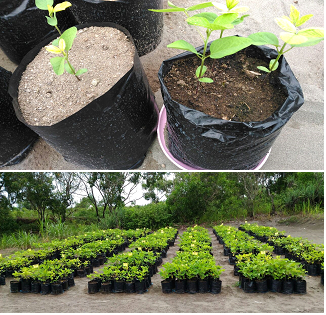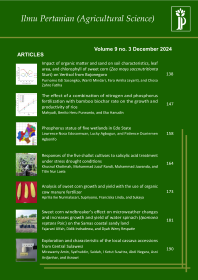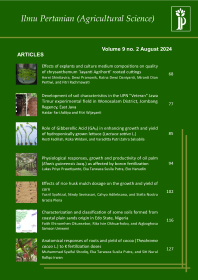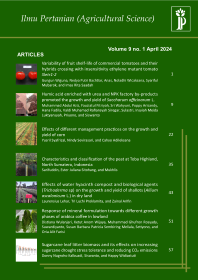
The Effect of Rhizobium japonicum on the Growth of Soybean Cultivars in Coastal Area
Okti Purwaningsih(1*), C. Tri Kusumastuti(2), Y. Sulistyo Nugroho(3), Casper Yoda Morib(4)
(1) Faculty of Agriculture Universitas PGRI Yogyakarta
(2) Faculty of Agriculture Universitas PGRI Yogyakarta
(3) Faculty of Agriculture Universitas PGRI Yogyakarta
(4) Faculty of Agriculture Universitas PGRI Yogyakarta
(*) Corresponding Author
Abstract
The natural resources of the coastal area in Indonesia have the potential to be developed as an agricultural land with the support of both cultivation technology and land processing, which one of them was done by using Rhizobium japonicum bacteria to meet the need of nitrogen in the soybean plants. This study aimed to determine the characteristics of nitrogen fixation in various soybean cultivars planted in the coastal area. The research was conducted in Mancingan, Parangtritis, Kretek, Bantul, DIY. The study was designed in Completely Randomized Design which consisted of two factors and was repeated three times. Factor I was Rhizobium japonicum inoculation (with inoculation and without inoculation); factor II was 10 various cultivars of soybean (Grobogan, Burangrang, Argomulyo, Anjasmara, Dena 1, Gema, Kaba, Wilis, Sinabung, Gepak Kuning). The results showed that the inoculation of Rhizobium japonicum in soybean cultivars in a coastal area could increase the number of root nodule, dry weight of root nodule, dry seed weight per plant, and harvest index. Burangrang cultivar planted in the coastal area was the most responsive to Rhizobium japonicum inoculation among other soybean cultivars tested.
Keywords
Full Text:
PDFReferences
Adie, M.M. and A. Krisnawati. 2014. Soybean opportunity as source of new energy in Indonesia. Int. Journal of Renewable Energy Development., 3:37-43.
Ali, M.E., D. Khanam., M.A.H. Bhuiyan., M.R. Khatun and M.R. Talukder. 2008. Effect of rhizobium inoculation to different varieties of gardenpea (Pisum sativum L.). J. Soil. Nature., 2:30-33.
Badan Pusat Statistik - The Central Institution of Statistics. 2016. Produksi kedelai menurut provinsi - soybean production by province data (ton), 1993-2015. https://www.bps.go.id/linkTableDinamis/view/871.
Badan Pusat Statistik - The Central Institution of Statistics. 2016. Luas panen kedelai menurut provinsi - the harvest area of soybean by province data. https://www.bps.go.id/dynamictable/2015/09/09/870/luas-panen-kedelai-menurut-provinsi-ha-1993-2015.html.
Dierolf, T., T. Fairhurst and E. Mutert. 2001. Soil fertility kit. Potash & Phosphate Institute of Canada.
Douka, C.E., A.E. Nychas and A.C. Xenoulis. 1986. Nitrogen fixation in soybeans as influenced by cultivar Rhizobium strain differences. Biology and Fertility of Soils., 2:113-118.
Farhoudi, R. and M.M. Tafti. 2011. Effect of salt stress on seedlings growth and ions homeostasis of soybean (Glysin Max) cultivars. Advances in Environmental Biology., 5: 2522-2526.
Gerendas, J. and Sattelmachner. 1990. Influence of nitrogen form and concentration on growth and ionic balance of tomato (Lycopersicon esculentum) and potato (Solanum tuberosum). Proceedings of the eleventh International Plant Nutrition Colloqium, 30 July – 4 August 1989. Wageningen, The Netherlands.
Gunadi, S. 2002. Teknologi pemanfaatan lahan marginal kawasan pesisir. Jurnal Teknologi Lingkungan - The Technology for Utilizing The Coastal Zone Marginal Land., 3:232-236.
Harun, M.U. and M. Ammar. 2001. Respon kedelai (Glycine max L. Merr) terhadap Bradyrhizobium japonicum strain Hup+ pada tanah masam. - The Response of soybeans (Glycine max L. Merr) to Bradyrhizobium japonicum Hup + strain on acid soils. Jurnal Ilmu-Ilmu Pertanian Indonesia., 2:111–116.
Karaca, U. and R. Uyanoz. 2012. The effectiveness of native Rhizobium on nodulation and growth properties of dry bean (Phaseolus vulgaris L.). African Journal of Biotechnology., 37:8986-8991.
Kertonegoro, B.D. 2006. Bahan humus tanah. Laboratorium Fisika Tanah Jurusan Ilmu Tanah Fakultas Pertanian - The Humus Material of Soil. Soil Physics Laboratory, Department of Soil Science, Faculty of Agriculture Universitas Gadjah Mada.
MacDicken, K.G. 1994. Selection and management of nitrogen-fixing trees. FAO/Winrock International Institute for Agricultural Development.
Purwaningsih, P., D. Indradewa, S. Kabirun, D. Shiddieq. 2012. The agronomic and physiological responses of soybean cultivar to the rhizobium japonicum inoculation and application of rice compost straw. Dissertation. Faculty of Agriculture, Universitas Gadjah Mada.
Sudihardjo, A.M. 2001. The shallot cultivation in the south coastal area of Yogyakarta sand shelf to support regional development. Proceedings of the Agricultural Technology Seminar to Support Agribusiness in Regional Economic Development and Food Security BPTP Yogyakarta.
Susanto, G. W. A. dan N. Nugrahaeni. 2017. Pengenalan Karakteristik Varietas Unggul Kedelai - The Introduction of The Characteristics of Soybean Superior Varieties. http://balitkabi.litbang.pertanian.go.id/wp-content/uploads/2018/03/bunga_rampai_2017_2_gatut.pdf
Yelton, M.M., S.S. Yang., S.A. Eddie., S.T. Lim. 1983. Characterization of an effective salt-tolerant, fast-growing strain of Rhizobium japonicum. Journal of General Microbiology., 129:1537-1547.Article Metrics
Refbacks
- There are currently no refbacks.
Ilmu Pertanian (Agricultural Science) ISSN 0126-4214 (print), ISSN 2527-7162 (online) is published by Faculty of Agriculture Universitas Gadjah Mada collaboration with Perhimpunan Sarjana Pertanian Indonesia (PISPI) and licensed under a Creative Commons Attribution-ShareAlike 4.0 International License.














